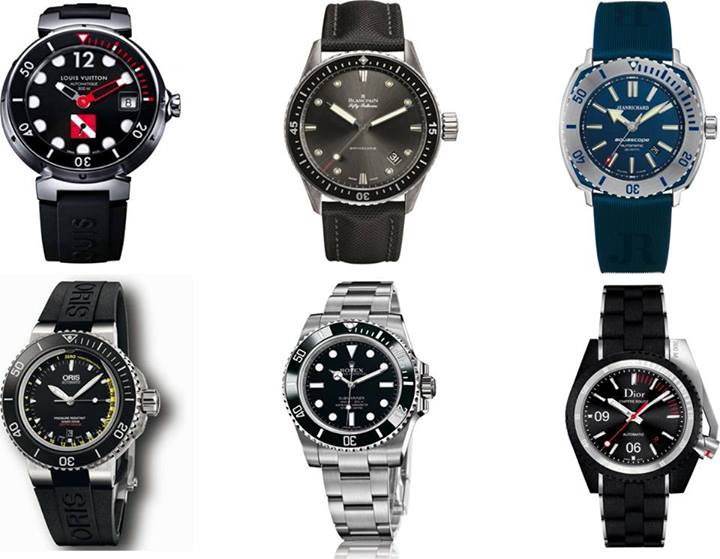Water Resistance vs. Water Proof
The U.S. FTC (Federal Trade Commission) which enforces the truth-of-advertising has deemed the term “Waterproof” inappropriate. In their opinion, a watch can never be 100% truly impervious to water, as the gaskets deteriorate over time & exposure, thus reducing the specified depth of water resistance. In the words of the FTC “The word proof connotes a measure of absolute protection that unfortunately does not exist with respect to watches, especially over prolonged periods of time.” The FTC has found the term Water Resistant to be more appropriate.
Water Resistance Testing Methods
There are 2 commonly used water-resistance testing methods:
Dry Test – The watch is placed in a chamber and the air-pressure is increased. The machine will detect the smallest variation in the case size. If the case expands, even slightly, then the watch is not water-resistant.
Wet Test – the watch is placed in a chamber which is half filled with water and half air. Air pressure is increased while the watch is out of the water, then the watch is slowly immersed into the water. Once the watch is completely immersed, the air pressure is slowly released. If bubbles come out of the watch it means that air seeped into the watch prior to immersion & the watch is not water-resistant. This method is generally used as a second test to pin-point the problem area.
ATM & BAR
ATM is short for “Atmosphere” which is equal to 10 meters. Another word for ATM which is commonly used in Europe is BAR – this too is equal to 10 meters.
Helium Escape Valve
The Helium Escape/Relief Valve is used only in extreme deep diving expeditions when a diver operates from a diving bell. As the bell is lowered pressure begins to increases & helium is added to the breathing mix. The helium is added to remove toxic air created by the extreme depth.
Helium is one of the smallest molecules & will seep into the watch through the seals until the air pressure in the watch equals the air pressure in the diving bell. As the diving bell surfaces & decompresses, the helium needs to escape from the watch at the same speed as the decompression – otherwise the pressure in the watch will pop the crystal off. To avoid that, Omega developed the helium escape valve which allows the helium to escape faster than it seeps in. Many brands use the escape valve in one design or another. Generally, the escape valve can be found on watches which have a water resistance rating of 300m or greater.
The helium escape valve never needs to be used in regular scuba diving unless diving in a controlled environment as described above.
Interpretation of the Depth Ratings
Although a watch may be rated 30m/99ft water-resistant, it does NOT mean that the watch can be immersed to that depth. The depth rating posted by the manufacturer is theoretical in nature and can only be achieved in a perfectly optimum environment of a laboratory – which is impossible to replicate in real life.
No Rating – 30m/99ft Does not allow contact with water
30m/99ft – 50m/165ft Allows for contact with water such as washing hands and rain
50m/165ft – 100m/330ft Allows for light poolside swimming
100m/330ft – 200m/660ft Allows for swimming, snorkeling and showering (do not expose to hot water)
200m/660ft – 500m/1650ft Allows for impact water sports such as board diving and scuba diving
500m/1650ft + Appropriate for serious deep water diving.
Obviously, the higher the rating, the more appropriate the watch is for deeper diving.
Recommendations:
– Have your watch water-tested once a year.
– Do not shower or swim with your watch unless it is rated 100m/330ft & has a screw-down crown.
– Never open, wind or operate the crown while in water.
– Never press the buttons of a chronograph watch while in water – unless otherwise stated by the manufacturer.
– Do not subject your watch to extreme temperature changes.
– Do not subject your watch to sudden & rapid air-pressure changes.
– Do not allow your watch to come in contact with corrosive chemicals, such as abrasive soaps & highly chlorinated water.
– Ensure that the crown is always pushed in, and if you have a screw-down crown make sure it is always tightened. Double-check before immersing in water.
Some example of diving watches
Pages: 1 2
Jonathan Kopp – Contributing Writer
Jonathan Kopp has an avid enthusiasm for timepieces of all genre, from vintage timepieces to modern Luxury Haute Horology. His preference goes to small and independent high-end watchmakers. He loves the difference rather than classicism, although if he admits to being in love with several ultra-classics pieces. Jonathan was caught by the passion for watchmaking there are almost 6 years. For about 5 years, he wanders in this industry and was Communication-Marketing-PR Consultant for several brands. He has worked for over 2 years as a freelance for the development of the Swiss brand Arthur Oskar Stampfli (AOSWatches). To keep in touch with Jonathan you can follow him on the various social networks:Instagram,Facebook and Twitter. Read his articles here.






